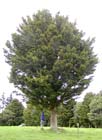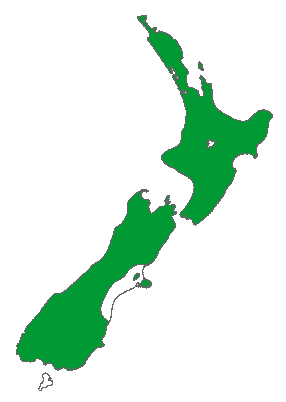Conservation Status

Podocarpus totara
G. Benn. ex D. Don in Lambert (1828)
Common names
Totara (Allan 1961).
Taxonomic notes
Syn: P. totara D. Don ex Hook. 1842; Nageia totara (G. Benn. ex D. Don) F. Muell. 1876 (Farjon 1998).
There is a natural hybrid with P. totara, Podocarpus × loderi Cockayne (1932). There is also one subspecies, Podocarpus totara G. Benn. ex D. Don var. waihoensis Wardle 1972, not recognized by some authors, thought to have originated as a hybrid between P. acutifolius and P. totara (New Zealand Plant Conservation Network 2010)
There is an unsolved mystery of biogeography affecting P. totara. In appearance it very closely resembles P. nubigenus, native to the Valdivian rainforests of South America (Chile, mainly); morphology and, to a degree, molecular data identify a close relationship between the two taxa. The same issue, close similarity in appearance, habitat, and molecular taxonomy, affects the species pair Prumnopitys taxifolia of New Zealand and Prumnopitys andina of South America. This evidently attests to a dispersal event in the distant past, but the nature and timing of that event remain unknown. The two areas have not had a land connection since the early Cretaceous, about 120 million years ago, which is a very long time for species pairs to maintain such a close similarity.
Description
Tall, slow-growing forest trees up to 30 m tall and 200 cm dbh. Bark thick, stringy, furrowed; cast in long strips, which shroud the trunk until falling. Leaves brownish to dark green; of juveniles ca. 2 cm × 1-2 mm; of adults 1.5-3 cm × 3-4 mm, linear-lanceolate, straight to slightly falcate, acute, pungent, coriaceous, patent, sessile by narrow base, midvein distinct or obscure. Pollen cones 1-1.5 cm long, solitary or up to 4 together on a short peduncle, surrounded by broad rigid scales; apiculus small, obtuse, sparingly denticulate. Female branchlets axillary, flowers solitary or paired, peduncle 2-3 mm long; receptacle of 2-4 scales, acute and free at tips, usually red, swollen and succulent, occasionally dry. Seed subglobose when mature, or ovoid-oblong, 3-5 mm long, nutlike (Allan 1961, Salmon 1996). See García Esteban et al. (2004) for a detailed characterization of the wood anatomy.
"In its early stages a totara forms a spreading, bushy and attractive tree. As it gains height it acquires a massive trunk and branches that bear dense foliage. Older trees become more open in habit and the top tends to die back. Enormous roots spread out over the ground at the base of the trunk " (Salmon 1996).
The var. waihoensis, which is thought to have arisen by hybridization between P. acutifolius and P. totara, resembles P. acutifolius in having a suckering root stock, multi-trunked growth form, and narrow needle-like leaves. Besides these characters, it also differs from the type variety of P. totara in having very slender branches (New Zealand Plant Conservation Network 2010).
Distribution and Ecology
New Zealand: N & S Islands, in lowland, montane and lower subalpine forest at 0-480(-600) m elevation (Allan 1961, Salmon 1996). The variety waihoensis occurs on the west coast of the South Island, from about the Waiho River south to the Cascades (New Zealand Plant Conservation Network 2010).
Based on data from 431 collection localities, its climate preferences include a mean annual temperature of 12°C, with an average minimum in the coldest month of 3°C, and a mean annual precipitation of 1880 mm (Biffin et al. 2011, Table S5). Zone 9 (cold hardiness limit between -6.6°C and -1.1°C) (Bannister and Neuner 2001).
Beveridge (1964) describes the dispersal and fate of seeds from New Zealand (Pureora Forest) podocarps. He reported that during a 10-year period, totara produced a small seed crop in every year, suggesting that this is not a masting species. The seeds ripen in May and June, and germinate in the following late spring and summer. Like nearly all podocarps, the totara is dispersed by birds that eat the seeds, digest the fleshy receptacle, and excrete the seed. Beveridge found that most podocarp seeds were dispersed by New Zealand pigeons (Hemiphaga novaeseelandiae), tuis (Prosthemadera novaeseelandiae) and bellbirds (Anthornis melanura). Beveridge also detailed the destruction of podocarp seed. Much seed is apparently destroyed in the tree's crown by animal (insect or bird) activity. The principal avian seed predator on totara was a native species, the yellow-crowned parakeet (Cyanoramphus auriceps), which consumed 40% of the seed crop in one year of observation. In contrast to some other podocarp species, totara seed was not heavily predated by non-native birds or rodents.
Lowland podocarp forest was originally a widespread New Zealand vegetation type, but has suffered the most severe losses of any forest type in the nation, with only about 1% of the original forest cover now surviving (Ebbett 1998). The surviving lowland mixed stands (variously dominated by P. totara, Dacrycarpus dacrydioides, and Prumnopitys taxifolia, alone or in combination) are confined to relatively fertile soils that reflect landform and disturbance, e.g. flood events on a river plain. These dominant tree species have differing nutrient, light, and disturbance regime requirements and these factors work together to partition the environment into optimal areas for the regeneration and persistence of each species. Stands dominated by P. totara are associated with relatively high light levels and relatively well-drained, fertile soils (Ebbett 1998).
Remarkable Specimens
The totara is the largest known tree in the Podocarpaceae. A tree called Pouakani, near Mangapehi in King Country, Southern Waikato, is 388 cm dbh and 42.7 m tall, with an estimated wood volume of 203.7 m3. This tree is well known. Note that a sign located at the base of the tree provides incorrect height, girth and wood volume information. The tree is located at 38.46716° S, 175.61928° E. A tree in Pureora Forest Park is 51 m tall (Robert Van Pelt e-mail 27-Jan-2003), and another at Pureora Forest Park has a dbh of 333 cm and is 27 m tall (Burstall and Sale 1984). One at Gwavas Station is said to have a dbh of 213 cm or 7 feet (IDS yearbook 1996, page 86, misreported as 7 m [Thomas Pakenham, pers. comm.]).
Certainly, totara live to great ages. Ages to 1800 years are attributed with no supporting evidence (Salmon 1996). The greatest data-based age I have is the 460-year-old cookie shown in the photo. There is also the case of a very old-looking tree in the Whirinaki forest that was cored by Ebbett (1992). One tree, growing on a ridgeline, yielded a radiocarbon date of 890 years from the inner portion of the core. Radiocarbon dates on tree cores from rotten trees are suspect, however, due to the possibility of carbon translocation by fungi in the wood, which could potentially produce deceptively young or old dates. Nonetheless, based on my observations of totara in habitat, I would not be surprised if an age exceeding 1000 years could be established.
Ethnobotany
See Conifers of New Zealand for a review of the historic role of forests in native and European cultures of New Zealand. Those impacts substantially affected this species.
Aboriginal use: "One of the largest trees in the forest, its timber was prized by Maori as being the best for building their massive war canoes, and was also the main timber used for carving. Until more recent times it was also valued for bridge and wharf construction, as well as a wide variety of other uses ... Ancient Maori custom demanded that when a totara tree was felled for timber a young seedling had to he planted in its place in order to appease Tane, the god of the forest, for removing one of his 'children' " (Metcalf 2002).
Economic importance: Bergin (2000) evaluates totara from a silvicultural standpoint and maintains that its growth characteristics, ecosystem values, cultural values, and broad ecological amplitude all suggest that it would make a viable species for commercial silviculture in New Zealand. Harvest of native New Zealand trees for timber was banned for many years, but since 2003, has been possible through the Tane Tree Trust, which recognizes that a "healthy and profitable indigenous forestry industry is key to large-scale planting for biodiversity, restoration and legacy purposes." Through the Trust, landowners can plant and subsequently harvest native trees, subject to certain regulations.
Research value: It does not appear that tree-ring chronologies have been constructed for the species. The earliest work seems to be that of Bell and Bell (1958, who found that samples from a given area could be correlated with each other, but also noted that "the totara ring patterns are difficult to read, however, confused by false rings, commonly distorted in growth, and often lacking in circuit uniformity." Long after, this finding was echoed by Norton and Ogden (1990), who described the species as subject to ring wedging: "Ring wedging occurs when rapid radial growth occurs over several years in certain segments of the tree's circumference, while being extremely slow or absent in others... Examination of complete cross sections can help overcome this problem, and for some species accurate age counts must be based on cross sections rather than increment cores."
Observations
This species is common and well-known in New Zealand, and is among the most popular of ornamental trees, besides which it readily establishes in pasture land. It may be the most popular New Zealand conifer planted in warm temperate areas around the world. The Pureora Forest Park area, as described above under "Big Tree," has the largest known totara. Fine large trees can be seen along many walks in the forest; ask at the local Department of Conservation office for more information. Large totaras can also be seen in most other outstanding native forests of the North Island, such as Whirinaki, Te Urewera, Puketi, Omahuta, Waipoua, and the flanks of Mts. Ruapehu and Taranaki. The species is also said to be widespread in lowland tropical forest of Fiordland National Park on the South Island.
Remarks
Subject to a fungal leaf spot disease caused by Corynelia tropica (Hood 1985).
Citations
Allan, H. H. 1961. Flora of New Zealand. Volume I, Indigenous Tracheophyta. Wellington: R.E. Owen Government Printer.
Bell, V. and R. E. Bell. 1958. Dendrochronological studies in New Zealand. Tree-Ring Bulletin 22:7-11.
Beveridge, A. E. 1964. Dispersal and destruction of seed in central North Island podocarp forests. Proceedings of the New Zealand Ecological Society 11:48-56.
Cockayne. 1932. Conifers in Cultivation: the Report of the Conifer Conference held by the Royal Horticultural Society, Nov. 10–12, 1931, ed. by F. J. Chittenden: p. 161.
Ebbett, R. L. 1992. Ecological characterisation of dense lowland podocarp forest, Whirinaki Sanctuary. Master of Environmental Science/Botany thesis, University of Auckland, Auckland. Text
119 p. Appendices 50 p.
Ebbett, R. L. 1998. The ecology of lowland totara in South Island, New Zealand. Dissertation, University of Canterbury. Available http://dx.doi.org/10.26021/1645, accessed 2021.04.12.
New Zealand Plant Conservation Network. 2010. Podocarpus totara var. waihoensis. http://nzpcn.org.nz/flora_details.asp?ID=1177, accessed 2011.10.14.
Rai Valley Centennial Committee. 1981. The Rai and Its People: A Centennial History of the Rai Valley District. Rai Valley, N.Z.: Rai Valley Centennial Committee.
See also
Bergin, D. O. and M. O. Kimberley. 1992. Provenance variation in Podocarpus totara. New Zealand Journal of Ecology 16(1):5-13.
Gymnosperms of New Zealand.
The New Zealand Plant Conservation Network, accessed 2010.11.22.
Simpson, Philip. 2017. Totara, a Natural and Cultural History. Auckland University Press. 288 pp. An excellent book, beautifully illustrated, covering all aspects of the species.











